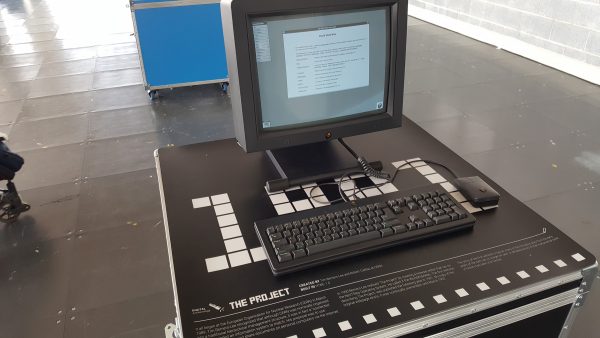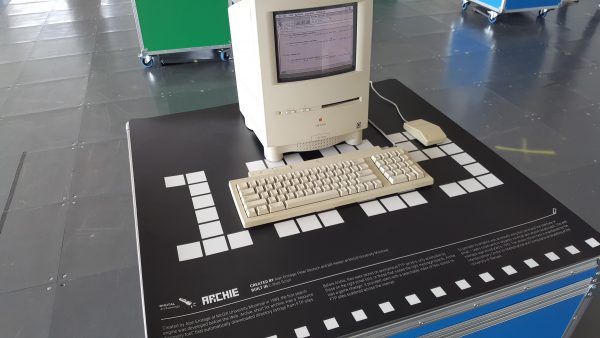For people of a certain age, there are few more nostalgia boosting views than a room full of flat beige boxes, each with a small dot-matrix owl on the top corner.
As part of a festival looking back at the history of website design, such a room now exists, at Here East in the Olympic Park.
Here East is a huge building at the top of the park, with a massive sign saying Here East on the top, but that’s not the building you want. Nor is the building next to it that says Here East reception.
In fact, you want the building marked Canalside, which is not at all confusing.
Having found the display, it’s essentially two for the price of one — a cluster of BBC Micros watiting to be programmed, and a collection of mostly old Apple computers displaying various notable stages in the evolution of website design.
Do start with the acoustic modem, and yes, the telephone will play you the dial-up sounds of early computers if you care to lift the handset. That long-lost sound that heralded a gateway to a wider more exciting world.
Whether you started with bulletin boards, or the early days of the internet, it was the handshake sound that turned a static computer into a communications device that could talk to anyone around the world.
Other there is the oldest website known to exist, the one written by Tim Berners-Lee, his original having been overwritten many times as no one back then thought to save webpages for posterity.
Maybe like long lost Dr Who episodes one day a backup tape will be found in an archive somewhere and the world goes crazy for the very first ever webpage.
Talking of first evers, there’s a copy of the first e-commerce website, that let you order pizzas online.
Dancing baby is here, the precursor to Minecraft, some of the first flash-based websites. We look back in horror at these flash-based websites, but it was early days, excitement was high, and understanding usability in its infancy.
One aspect I had forgotten was just how small computer screens were back then, then again, today half of website traffic is via a mobile phone, so maybe the old computer screens weren’t so bad after all.
Of course, it’s the bank of BBC Micros that bring back memories of days laboriously typing in lines of code from magazines and experimenting with writing your own programmes.
You’re free to type away, and copies of old BBC Micro coding books are left lying around to remind you just how that GOSUB routine worked.
The display, 64 Bits: An exhibition of the Web’s lost past is open daily until the 21st April. Entry is free.














Thanks for coming Ian. A few more dates for your diary:
Friday 7th April: Code with our Kids – parents and children coding lessons by the Computer History Museum
Saturday 8th April: Code Amnesty – Artists and Designers, bring in your old floppy disks and CDs and be part of the show
Saturday 15th April: Family Day – Create your own pixel art with Stickaz and Easter egg hunt
Jim Boulton – curator #64Bits
I have my faithful BBC B computer complete with printer and some large floppy discs, which helped to get me through my degree in the mid 1980’s. It now lives in my loft and I’ve been wondering if anyone would want it or shall I take it to the tip? Any advice, please. In live in the wilds of Herefordshire but I was born and brought up in the middle of London, ages ago – which is why I love your posts about what’s going on in London. Thanks!
Whatever you do, don’t take it to the tip! There are plenty of projects like the above that could make use of it. Also, off the top of my head there is the The National Museum of Computing at Bletchley Park and the Centre for Computing History in Cambridge.
Failing that, I’ll take it off your hands for a nostalgia injection (first computer I used was a BBC B that I wheeled around my primary school).
Further to Stuart’s reply they also currently sell on ebay for £ 50+, so agreed, don’t take it to the tip!
I’m sure someone will take it off your hands, there are facebook groups dedicated to selling retro computers – e.g., Retro For Sale.
One piece of advice if you have an old BBC – don’t plug it in! (At least not without checking it carefully first).
Most of the hardware should have survived perfectly, but there’s a large capacity that is known to dry out with time. If that’s happened and you plug it in you’re liable to cause more damage. They’re easy to replace apparently. Just google.